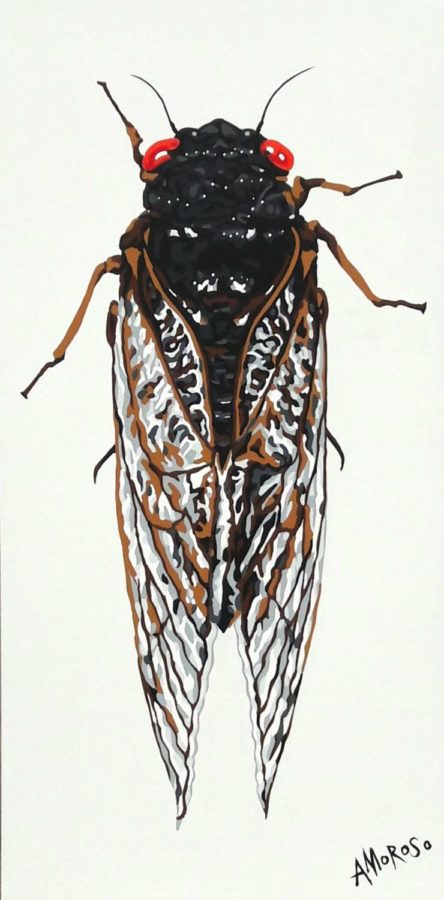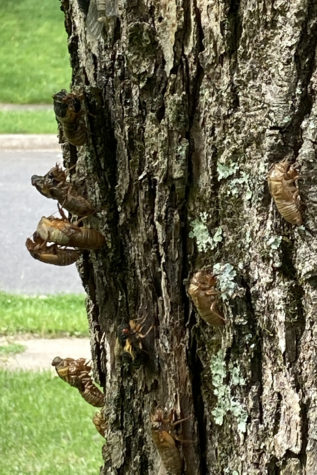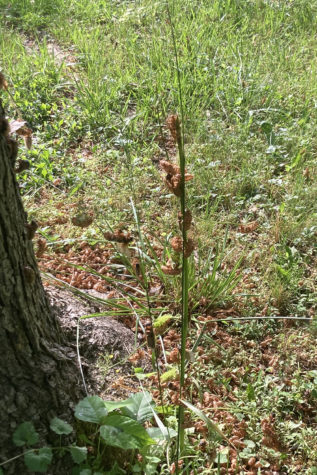Sound the Alarm! Cicadas are Back
Cicada Mating Call Sounds Like Flying Saucer

For some, the words “Brood X” might strike fear or excitement. Either way, put on your seatbelt and brace yourself for the swarm of billions and billions of cicadas already emerging, aka Brood X. While Cicadas are a regular part of a Virginia summer, Brood X only comes out once every 17 years.
These insects, according to science teacher Elizabeth Schinstock, spend most of their lifespan underground. During that time, they molt or shed their exoskeleton around five different times. They feed on liquid sucked from the roots of plants. Despite her knowledge of the insect, Ms. Schinstock is among those who look upon the arrival of Brood X with uneasiness.
“I’m good with small insects, but the bigger ones can be creepy, especially when they unexpectedly land on me. Large eyes on insects are what I dislike the most.”
Cicadas are well known for their beady red eyes, which tend to scare people off.
“I remember when the cicadas were around 17 years ago,” Schinstock recalled. “I didn’t like them, but I did find them fascinating. Their life cycles are what intrigue me. Even if I didn’t like the cicadas when they were here last time, I couldn’t show that to my kids. I tried to remain calm because I didn’t want to cause them to have a fear of bugs. Insects are an important part of our food chain, and our planet needs them to sustain life.”
History teacher Stephanie Haley is also a bug enthusiast, and unlike Ms. Schinstock, cicadas are one of her favorites.
“For me, cicadas are right at the top of my list,” she said. “The periodical cicadas are not as attractive, but I still like them a lot. I know attractive cicadas sound like a contradiction in terms,” she joked.
Haley often adopts bugs, like butterflies or praying mantises, and raises them in her home, but she can’t do that with cicadas.
“They’re impossible to raise because of their diet, which is basically chugging down tree sap. I have had the opportunity a few times to watch them emerge from their subterranean form into the winged creature, and it was awesome.”


Once the soil about a foot deep reaches exactly 64 degrees, this brood will blanket 15 states: Delaware, Georgia, Illinois, Indiana, Kentucky, Maryland, Michigan, New Jersey, New York, North Carolina, Ohio, Pennsylvania, Tennessee, Virginia, and West Virginia.
According to EarthSky, a website dedicated to daily updates on the cosmos and world, for about four to six weeks after the cicadas emerge, the sound of their mating calls will fill everywhere you go. After they mate, the females will lay their eggs, and the adult cicadas will die.
Cicadas’ main purpose, once they’ve emerged, is breeding. Both male and female cicadas make sounds to attract mates. Although the male sounds tend to be annoying and remind people of a softer lawn mower or chainsaw sounds, they are very memorable.
“Their song reminds me of summers I spent with my Grandma. She referred to them as ‘jar flies’ and would warn my sister and I each morning that their songs were indicators of a hotter day than the last,” said Ms. Haley, noting that her memories are from standard cicadas not Brood X.
Female cicadas make a snapping noise when looking for males. The males are so focused and drawn to the sound that if you snap your fingers next to one, they will follow your hand as you’re snapping.
Cicadas are often compared to locusts and seen as scary or bad when they aren’t even in the same category of bugs.
“It drives me nuts when people mistake that,” Haley emphasized.
There were biblical plagues of locusts that would eat entire crops. Therefore people tend not to like them and often think cicadas are the same. To be clear, cicadas are NOT locusts. According to Ms. Schinstock, the cicadas are harmless to our environment.

“I don’t think they will negatively change the environment that much. They have been around since the dinosaurs, so that is a long time,” said Schinstock.
To clarify, she noted that they will have a short-term effect on our human environment, meaning they will be noticeable and make some people uncomfortable, but they shouldn’t hurt the landscape. Ms. Haley agreed.
“They’ll be everywhere, but they’re harmless and a good food source for many other animals.”
Brood X is the largest brood of the 17-year cicada, so they might look very intimidating being able to grow up to 2.25 inches long, but they can’t sting and aren’t venomous, so they can’t hurt anyone. Plus, they are completely harmless to crops. Cicadas don’t even have the right mouthparts to eat crops or jumping legs.
Ms. Haley would love to see these insects become more accepted by their next visit. She envisions a children’s picture book.
“They’re like time capsules: think about how different it was 13 or 17 years ago. The realization of the changes would be fun to write about,” said Haley.











